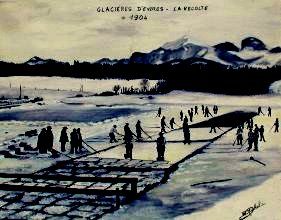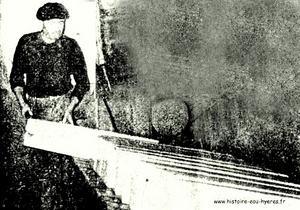|

Ce n'est pas le plus bel endroit de la région, mais un peu d'histoire ne fait pas de mal!
Le grand espace au niveau du parking était un lac qui depuis a été en grande partie "comblé".
Sur ce lac existait une activité étonnante
A la fin du XIXème siècle, un certain Emmanuel Gobert a eu l'idée de fournir de la glace en plein été aux commerçants d'Annecy et de La Roche. C'est donc de ce petit village haut savoyard que sortit en 1810, le premier glaçon conçu par l'ingéniosité de l'homme. Petite idée qui allait faire son chemin.: Il s'agissait d'emmagasiner en hiver dans un local bien protégé, les plaques de glace récoltées au fur et à mesure de leur formation sur la surface d'un étang.

Le travail sur la glace
Les hivers autrefois étaient beaucoup plus long et surtout beaucoup plus froid, la température descendait souvent jusqu'à -20°
Une source située sur la commune d'Eteaux fût captée et fût amenée jusqu'à un étang qu'il avait fait creuser et sur les bords duquel des glissières de bois disposées en biais permettaient de diriger les blocs de glace à l'entrée et au milieu de l'entrepôt "la glacière" qu'il avait fait construire au bord du ruisseau de Daudens, entre la gare d'Evires et la route nationale La Roche-Annecy
La "glacière" était construite en bois, avec des parois isolées par une couche épaisse de sciure ,à proximité de la gare et desservie par une voie ferrée.
Elle avait plus de 900 m2 de superficie. Elle fut reconstruite de 1889 à 1892 avec des piliers de pierre et de béton armé, ce qui constituait alors une innovation technique.
Cette glacière, par chemin de fer alimentait le sud de la France et la région parisienne. Les Wagons fermés et emballés par de la paille conservait la glace correctement. Les pertes constatées n'étaient que de 20%.
L'entreprise, sous différents propriétaires, fonctionna jusqu'en 1945. Elle donnait un travail d'appoint aux cultivateurs (jusqu'à 40 personnes dans l'année 1900) qui s'occupaient en hiver à découper les blocs de glace de 25 cm d'épaisseur sur 1m de longueur.

Ces blocs étaient ensuite empilés

A voir:
Dans l'ancien bâtiment de la glacière, une scierie s'est installée. On peut facilement en voir les" vestiges" le week-end.
En semaine c'est peut être un peu plus délicat.
Pour les coordonnés, c'est l'étape nommée Glacière
|